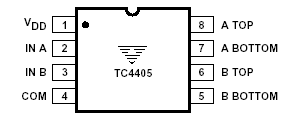Features: ` Independently-Programmable Rise and Fall Times
` Low Output Impedance ................................ 7 Typ
` High Speed tR, tF ....... <30 nsec with 1000 pF Load
` Short Delay Times ....................................< 30 nsec
` Wide Operating Range .......................... 4.5V to 18V
`Latch-Up Protected ......... Will Withstand >500 mA Reverse Current (Either Polarity)
` Input Withstands Negative Swings Up to 5VApplication· Motor Controls
· Driving Bipolar Transistors
· Driver for Nonoverlapping Totem Poles
·Reach-Up/Reach-Down DriverPinout
Specifications| Power | Dual |
| Peak Output Current (mA) | 1500 |
| Output Resistance (RH/RL)(Max. @ 25°C) | 10/10 |
| Max. Supply Voltage (V) | 18 |
| Input/Output Delay (td1, td2)1 (ns) | 30/50 |
| Configuration | Non-Inverting |
| Description | Low-Side MOSFET Drivers, 1.5A Peak Output Current |
| Operating Temp. Range (°C) | -40 to 85 |
| Power |
Dual |
| Peak Output Current (mA) |
1500 |
| Output Resistance (RH/RL)(Max. @ 25°C) |
10/10 |
| Max. Supply Voltage (V) |
18 |
| Input/Output Delay (td1, td2)1 (ns) |
30/50 |
| Configuration |
Non-Inverting |
| Description |
Low-Side MOSFET Drivers, 1.5A Peak Output Current |
| Operating Temp. Range (°C) |
-40 to 85 |
Supply Voltage ......................................................... +22V
Maximum Chip Temperature................................... +150
Storage Temperature Range .................. 65to +150
Lead Temperature (Soldering, 10 sec) ................... +300
Package Thermal Resistance
CerDIP RJ-A ................................................... 150/W
CerDIP RqJ-C ................................................... 55/W
PDIP RJ-A ...................................................... 125/W
PDIP RJ-C ........................................................ 45/W
SOIC RJ-A ..................................................... 155/W
SOIC RJ-C ....................................................... 45/W
Operating Temperature Range
C Version .................................................. 0 to +70
E Version ............................................ 40 to +85
M Version .......................................... 55 to +125
Package Power Dissipation (TA 70)
Plastic ................................................................730mW
CerDP ................................................................800mW
SOIC ..................................................................470mW
*Static-sensitive device. Unused devices must be stored in conductive material. Protect devices from static discharge and static fields. Stresses above those listed under Absolute Maximum Ratings may cause permanent damage to the device. These are stress ratings only and functional operation of the device at these or any other conditions above those indicated in the operational sections of the specifications is not implied. Exposure to Absolute Maximum Rating Conditions for extended periods may affect device reliability.
Description The TC4404 and TC4405 are CMOS buffer-drivers constructed with complementary MOS outputs, where the drains of the totem-pole output have been left separated so that individual connections can be made to the pull-up and pull-down sections of the output. This allows the insertion of drain-current-limiting resistors in the pull-up and/or pull-down sections, allowing the user to define the rates of rise and fall for a capacitive load; or a reduced output swing, if driving a resistive load, or to limit base current, when driving a bipolar transistor. Minimum rise and fall times, with no resistors, will be less than 30nsec for a 1000pF load. There is no upper limit. For driving MOSFETs in motor-control applications, where slow-ON/fast-OFF operation is desired, these devices are superior to the previously-used technique of adding a diode-resistor combination between the driver output and the MOSFET, because they allow accurate control of turn-ON, while maintaining fast turn-OFF and maximum noise immunity for an OFF device. When used to drive bipolar transistors, these drivers maintain the high speeds common to other Microchip drivers. They allow insertion of a base current-limiting resistor, while providing a separate half-output for fast turn-OFF. By proper positioning of the resistor, either npn or pnp transistors can be driven. For driving many loads in low-power regimes, these drivers, because they eliminate shoot-through currents in the output stage, require significantly less power at higher frequencies, and can be helpful in meeting low-power budgets. Because neither drain in an output is dependent on the other, these devices can also be used as open-drain buffer/drivers where both drains are available in one device, thus minimizing chip count. Unused open drains should be returned to the supply rail that their device sources are connected to (pull-downs to ground, pull-ups to VDD), to prevent static damage. In addition, in situations where timing resistors or other means of limiting crossover currents are used, like drains may be paralleled for greater current carrying capacity. These devices are built to operate in the most demanding electrical environments. They will not latch up under any conditions within their power and voltage ratings; they are not subject to damage when up to 5V of noise spiking of either polarity occurs on their ground pin; and they can accept, without damage or logic upset, up to 1/2 amp of reverse current (of either polarity) being forced back into their outputs. All terminals are fully protected against up to 2 kV of electrostatic discharge.

 TC4405 Data Sheet
TC4405 Data Sheet








